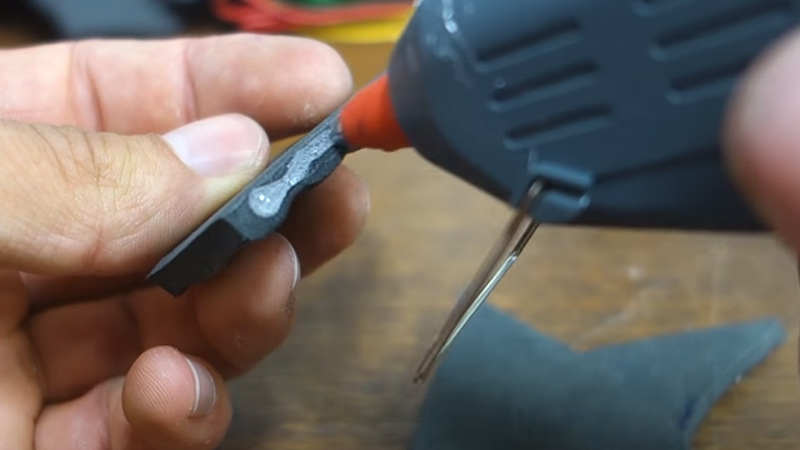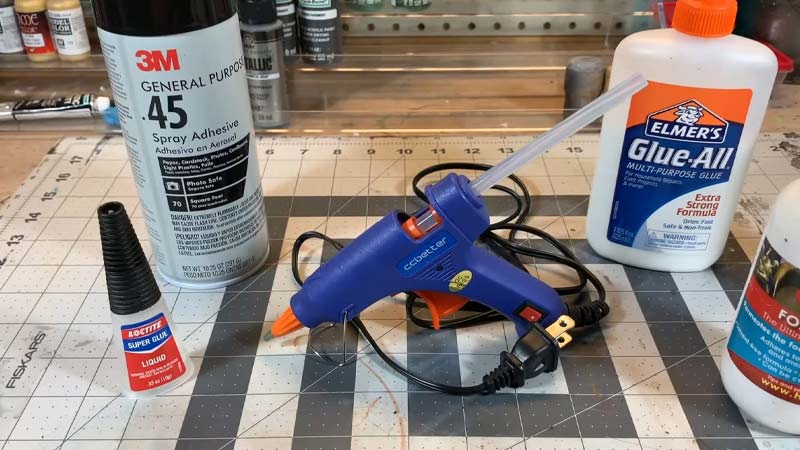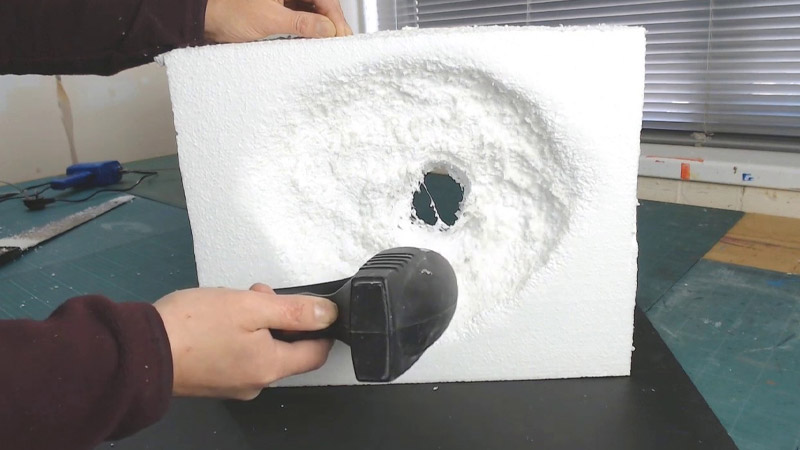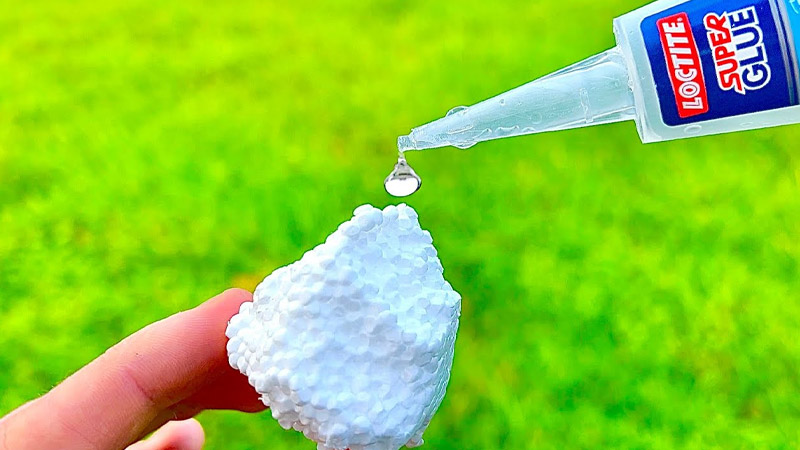Hot glue is a popular adhesive choice in the realm of crafting and DIY projects due to its versatility and fast bonding properties.
However, the question that often arises in the creative process is whether hot glue has the potential to melt craft foam, a commonly used material in various craft endeavors.
This concern stems from the fact that hot glue is heated to a high temperature before application, which can raise doubts about its compatibility with foam-based materials.
In this exploration, we delve into the interaction between hot glue and craft foam, examining the factors that influence the outcome and offering insights into how to use hot glue effectively without compromising the integrity of your foam creations.

What Is Hot Glue?
Hot glue, also known as hot melt adhesive, is a versatile and widely used adhesive in various crafting, DIY, and industrial applications.
It is composed of thermoplastic polymers that are solid at room temperature but become liquid when heated.
To use hot glue, a hot glue gun is employed, which heats a solid glue stick, melting it into a viscous liquid form. When applied to surfaces, the hot glue quickly cools and solidifies, forming a strong bond.
Hot glue is favored for its quick drying time, strong adhesion to a wide range of materials, and ease of use. It finds applications in arts and crafts, woodworking, electronics, and more.
Does Hot Glue Melt Craft Foam?
Hot glue does melt craft foam, and this can be both an advantage and a disadvantage, depending on your project and how you use it.
If you’re considering using hot glue with craft foam, it’s common to raise a question: does hot glue melt foam?
Hot glue is a commonly used adhesive in crafting due to its quick drying time and strong bond. When used with craft foam, hot glue can interact in several ways, and understanding these interactions is essential for successful crafting with these materials
Here is how hot glue interacts with craft foam:
Melting and Bonding
Hot glue is called “hot” for a reason it is applied in a molten state. When you apply hot glue to craft foam, it can cause the foam to melt slightly at the point of contact.
As it cools and solidifies, it forms a strong bond between the pieces of foam. This melting action can be an advantage when you want a secure and quick bond between foam pieces.
Quick Drying
One of the primary benefits of hot glue is its rapid drying time. This allows you to work efficiently and move on to the next step of your project without waiting for the adhesive to be set for an extended period.
Risk of Damage
While hot glue is effective at bonding craft foam, it can potentially damage the foam if not used carefully.
Excessive heat and pressure can lead to more melting than necessary, causing deformities or even holes in the foam. This is particularly true when using high-temperature glue guns.
Visible Seams
The melted foam may leave visible seams or marks on the surface of your craft foam. Depending on your project, these seams can be noticeable and may require additional finishing or concealing.
What Glue Works Best on Craft Foam?

Craft foam is a versatile material commonly used in various craft projects, and finding the right glue is essential to ensure a strong bond without damaging the foam.
The best glue for craft foam depends on your specific project and preferences, but here are some glues commonly used and recommended for adhering craft foam:
Craft Glue
Craft glue or white glue (e.g., Elmer’s Glue-All) is a good choice for bonding craft foam. It’s non-toxic, dries clear, and is easy to work with.
Apply a thin layer to both surfaces you want to bond, press them together, and allow them to dry.
Hot Glue
Hot glue guns and hot glue sticks are commonly used for adhering craft foam. They create a strong bond quickly.
However, be cautious with this method, as hot glue can melt foam if applied too hot or too thick.
Spray Adhesive
Spray adhesives, such as 3M Super 77 or Aleene’s Tacky Spray, can provide an even coat of adhesive on both surfaces. This is particularly useful for larger craft foam pieces or when you want a uniform bond.
Double-Sided Tape
Double-sided tape with a strong adhesive backing can be a convenient and mess-free option for attaching craft foam to various surfaces. It’s often used for card-making and paper crafts.
Foam-Specific Adhesive
Some manufacturers produce adhesives specifically designed for foam, such as EVA foam. These adhesives are formulated to bond effectively without damaging the foam.
Contact Cement
Contact cement, like DAP Weldwood or Barge Cement, can work well for craft foam. Apply a thin layer to both surfaces, let it dry until tacky, and then press the pieces together. Be sure to follow safety precautions and use it in a well-ventilated area.
How to Melt Styrofoam With Heat?

Melted styrofoam can release harmful fumes and is generally not recommended due to safety and environmental concerns.
Styrofoam, which is a brand name for expanded polystyrene foam, is made up of a combination of chemicals, including styrene, which can release toxic gases when exposed to high temperatures.
If you have a specific project or need to work with styrofoam, it’s better to use other methods like cutting, shaping, or bonding, rather than trying to melt it with heat.
Here’s how to work with styrofoam safely:
Cutting
You can easily cut styrofoam with a sharp knife, a craft blade, or hot wire foam cutters. These methods allow you to create precise shapes without the need for melting.
Shaping
You can shape styrofoam by sanding it with sandpaper, using a Dremel tool, or carving it with specialized foam carving tools.
Bonding
To join pieces of styrofoam together, use adhesives like white glue or a low-temperature hot glue gun. Avoid high-temperature hot glue guns, as they can melt the foam.
Painting
You can paint styrofoam with acrylic paints, but be cautious not to use solvents that can dissolve the foam.
Safety Precautions
When working with styrofoam, always do so in a well-ventilated area to minimize exposure to any fumes. Wear gloves and a dust mask when sanding or cutting styrofoam to protect yourself.
Why Does Super Glue Melt Styrofoam?

Super glue, also known as cyanoacrylate adhesive, can appear to melt styrofoam, but it doesn’t actually melt the material like heat would.
What happens is a chemical reaction between the super glue and the styrofoam, causing the styrofoam to break down.
Here’s why this occurs:
Acetone Content
Many superglue formulations contain small amounts of acetone or similar solvents. Acetone is a powerful solvent that can dissolve styrofoam.
When you apply super glue to styrofoam, the acetone in the glue begins to dissolve the styrofoam’s surface. This dissolution process can give the appearance of melting.
Exothermic Reaction
The curing process of superglue is exothermic, meaning it generates heat as it hardens. This heat can contribute to the breakdown of the styrofoam, causing it to soften and deform.
Chemical Reaction
The adhesive properties of superglue rely on a chemical reaction with moisture in the air (or on the surfaces being bonded).
This reaction can create heat and may also contribute to the breakdown of the styrofoam.
FAQS
Will Hot Glue Melt Foam?
Hot glue has the potential to melt foam, particularly if it’s applied at high temperatures or in excess.
Can You Hot Glue Foam Board?
Yes, you can hot glue foam board. It’s a common adhesive choice for foam board projects.
Can I Use a Low-Temperature Hot Glue Gun on Craft Foam?
Yes, using a low-temperature hot glue gun is generally safer for craft foam.
Can I Double-Up Craft Foam to Prevent Melting with Hot Glue?
Layering craft foam can provide extra protection against melting, especially if you use low-temperature hot glue. This can make your project more durable.
What’s the Ideal Thickness of Craft Foam to Avoid Melting?
The ideal thickness of craft foam to avoid melting is 4mm to 6 mm.
To Recap
The compatibility between hot glue and craft foam hinges on several crucial factors. While hot glue can be a valuable adhesive for a wide range of crafting projects, it has the potential to melt or distort craft foam due to its high temperature.
To mitigate this risk, it’s essential to consider the type of hot glue gun used opting for a low-temperature gun, and the thickness of the craft foam.
Additionally, taking precautions such as allowing the glue to cool before handling the project and using protective coatings can help ensure successful bonding without compromising the integrity of the foam.
Ultimately, with careful attention to these variables, you can harness the benefits of hot glue while preserving the structural integrity of your craft foam creations.
Leave a Reply